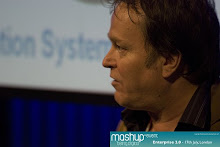Reflecting on recent discussions, Tweets and other online threads, there seem to be two reoccurring and related topics:
- Making Enterprise Architecture valuable
- Selling the need for Enterprise Architecture practice to CxOs.
Values = ‘The things cared about”
Value = “The worth of an interaction between Systems”.
How do the V’s apply across an Enterprise? My definition of Enterprise includes the subject organization’s relationship with customers, markets, and trading-partner communities.
Value Network Analysis seems to provide one of the simplest ways to represent these relationships, in this System-of-systems, we call the Enterprise. Value Network Maps are a representation of the Roles (sub-systems) and the interactions between them. Each Role has a set of dominant Values (things-they-care-about) and a number of ‘transactions’ that produce and consume tangible and intangible value with other Roles.
I believe understanding “The Enterprise” as a complex system of interacting Values and Value-Transactions is fundamental to selling the need for Enterprise Architecture as a practice (note: whether or not someone carries the title ‘Enterprise Architect’). A recent LinkedIn discussion with Verna Allee helped clarify this perspective:
“… value network mapping indeed provides an overlay for business processes. … This gives you a "process" view, but it is one with all of the key intangible interactions built into the process and not mysteriously hanging outside. At Boeing VNA is their Lean + tool and they use it extensively prior to doing the deep dive into process modeling. It serves as that reality check to be sure that a) all of the critical interactions are addressed and b) the processes do not become over structured in contrast to what is most essential.
The discovery, and the concise abstraction of ‘The System-of-Values’ across the enterprise, seem critical to understanding the style of EA required and its “Worth” to the subject organisation.
The ‘Systems-Of-Values’, will vary, sometimes dramatically, from company to company and will change over time depending on all sorts of factors from market demand to changes in leadership.
Brenda Michelson recently commented that she always does anthropology before architecture; I believe this exploration of the ‘V’s’ aligns with that thought. I also believe, that it is possible to create a usefully abstracted, values-based reference model of the enterprise that acts as a grounding-point subsequent views of EA (e.g. process, information and technology).
This worldview of EA seems all the more important as governments and businesses need to become more connected to external organisations to stay relevant and aligned with the values of their citizens, customers and trading-partners.








